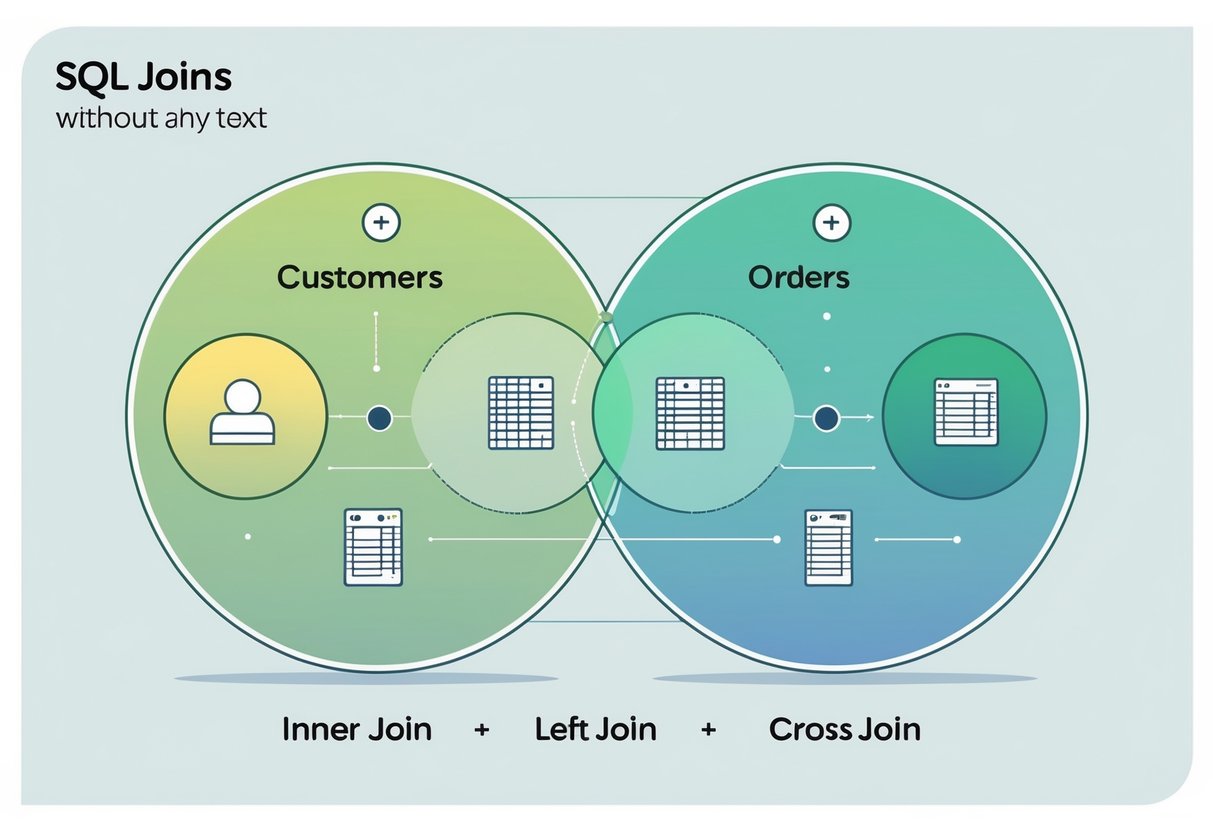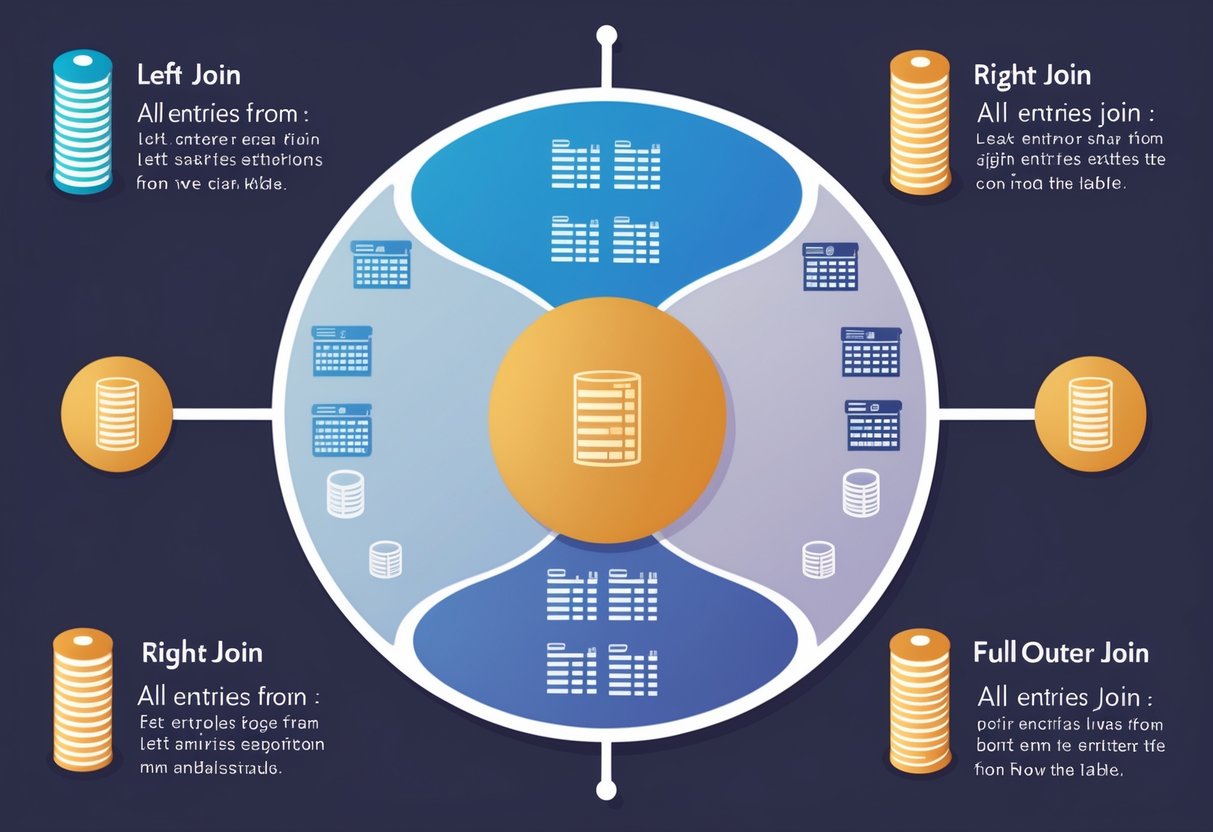Working with data from multiple tables is one of the most common tasks in SQL. SQL joins are commands that combine rows from two or more tables based on related columns between them, allowing you to access and analyze data that spans multiple tables in a single query.
Understanding joins is essential for anyone working with relational databases.

Most databases store information across several tables rather than in one large table. For example, a business might have separate tables for customers, orders, and products.
SQL JOIN clauses help combine rows from two or more tables to create meaningful reports and insights from this distributed data.
This guide breaks down the different types of joins and explains when to use each one. It also provides practical tips for writing effective join queries.
Key Takeaways
- SQL joins combine data from multiple tables using related columns
- Different join types return different sets of results, so choosing the right one depends on what data you need
- Practice with real examples and understanding table relationships makes writing joins much easier
What Are SQL Joins?

SQL joins combine data from two or more tables using shared columns to create a single result set. They solve the problem of data spread across multiple tables by linking related information together.
Definition of SQL Joins
A SQL JOIN clause combines rows from multiple tables based on a related column between them. The join operation matches values in specified columns to determine which rows to include in the final result.
Joins work by comparing values in columns that exist in both tables. When the database finds matching values, it combines the corresponding rows into a single row in the output.
Common join elements include:
- Source tables – The tables being combined
- Join condition – The rule that determines how rows match
- Shared columns – Columns that exist in multiple tables with related data
For example, an Orders table might have a CustomerID column that matches the CustomerID column in a Customers table. The join uses these matching IDs to connect order information with customer details.
Why Joins Are Needed in Relational Databases
Databases usually have more than one table to organize information efficiently. This design prevents data duplication and keeps related information separate.
Without joins, users would need to run multiple separate queries and manually combine results. This approach creates more work and increases the chance of errors.
Joins solve these key problems:
- Eliminate duplicate data storage
- Connect related information from different tables
- Allow complex queries across multiple data sources
- Maintain data consistency and organization
Consider a business database with separate tables for customers, orders, and products. Joins allow queries that show which customers bought which products, even though this information spans three different tables.
How Joins Work
Joins establish logical relationships between tables by comparing values in specified columns. The database engine examines each row from the first table and looks for matching values in the second table.
The basic process involves three steps. First, the database identifies the columns to compare based on the join condition. Second, it compares values between these columns across all rows.
Third, it combines matching rows into the final result set.
Join syntax follows this pattern:
SELECT columns
FROM table1
JOIN table2 ON table1.column = table2.column
The ON clause specifies which columns to compare. Different join types determine what happens when matches are found or not found between the tables.
Key Types of SQL Joins
SQL joins work by matching data between tables using common columns. Each join type returns different combinations of records depending on whether matches exist in one or both tables.
INNER JOIN Explained
INNER JOIN returns records that have matching values in both tables. This join type only shows rows where the join condition is met in both tables.
When two tables share a common column, INNER JOIN finds rows with identical values in that column. It excludes any rows that don’t have matches.
Example scenario: A customers table and an orders table both contain a customer_id column. INNER JOIN would show only customers who have placed orders.
The syntax follows this pattern:
SELECT columns
FROM table1
INNER JOIN table2
ON table1.column = table2.column
INNER JOIN is the most restrictive join type. It filters out incomplete data and focuses on complete relationships between tables.
LEFT JOIN Explained
LEFT JOIN returns all records from the left table and matched records from the right table. When no match exists, the result shows NULL values for the right table columns.
The left table is the first table mentioned in the FROM clause. This join preserves every row from the left table regardless of matches.
Example scenario: Show all customers and their orders. Customers without orders still appear in results with NULL values in order columns.
LEFT JOIN helps identify missing data relationships. It answers questions like “which customers haven’t placed orders” or “which products haven’t been sold.”
The syntax structure:
SELECT columns
FROM left_table
LEFT JOIN right_table
ON left_table.column = right_table.column
This join type is useful for finding gaps in data or creating reports that need complete records from one table.
RIGHT JOIN Explained
RIGHT JOIN works opposite to LEFT JOIN. It returns all records from the right table and matched records from the left table.
The right table is the second table mentioned in the JOIN clause. Every row from this table appears in results, even without matches from the left table.
Example scenario: Show all products and customer purchases. Products that haven’t been bought still appear with NULL customer information.
Most databases support RIGHT JOIN, but many developers prefer LEFT JOIN instead. They simply switch the table order to achieve the same result.
The syntax pattern:
SELECT columns
FROM left_table
RIGHT JOIN right_table
ON left_table.column = right_table.column
RIGHT JOIN is less common than LEFT JOIN in practice. Many SQL developers find LEFT JOIN more intuitive to read and understand.
FULL JOIN Explained
FULL JOIN combines LEFT JOIN and RIGHT JOIN results. It returns all records from both tables, showing matches where they exist and NULL values where they don’t.
This join type creates the most complete dataset possible from two tables. No rows are excluded from either table.
Example scenario: Show all customers and all orders, including customers without orders and orders without valid customer records.
FULL JOIN reveals data quality issues. It highlights orphaned records and missing relationships between tables.
The syntax follows:
SELECT columns
FROM table1
FULL JOIN table2
ON table1.column = table2.column
FULL JOIN produces the largest result sets. It’s useful for data analysis and finding inconsistencies between related tables.
Choosing the Right SQL Join
Selecting the correct join type depends on whether you need all records from one table, only matching records, or complete data from both tables. The key factors are data completeness requirements and business logic needs.
When to Use Each SQL Join
INNER JOIN works best when you only want records that exist in both tables. Use this join to find customers who have placed orders or employees who have completed training.
LEFT JOIN keeps all records from the first table and matches from the second. Choose this when you need every customer record, even those without orders.
RIGHT JOIN does the opposite – it keeps all records from the second table. Use this less frequently, mainly when you want all orders even if customer data is missing.
FULL JOIN combines both tables completely, showing all records with NULL values where matches don’t exist. This join helps identify data gaps in both tables simultaneously.
CROSS JOIN creates every possible combination between tables. Use this sparingly, only when you need all product-category combinations or similar scenarios.
Examples of Common Join Use Cases
E-commerce databases use INNER JOIN to connect customers with their orders, showing only active buyers.
Customer service teams use LEFT JOIN to see all customers and their support tickets. This reveals which customers never contacted support.
Inventory systems use FULL JOIN to compare product catalogs with supplier lists. This identifies discontinued items and new products that need setup.
Marketing departments use CROSS JOIN to create all possible email template and customer segment combinations for A/B testing campaigns.
Practical Tips for Writing Joins

Writing effective joins requires following proper syntax practices and understanding common mistakes that can lead to incorrect results.
Best Practices for Join Syntax
Always use explicit join syntax with the JOIN and ON keywords rather than implicit joins. This approach makes queries more readable and prevents confusion between join conditions and filtering conditions.
Use descriptive table aliases to simplify long table names. Choose meaningful abbreviations like c for customers or ord for orders.
SELECT c.name, ord.date
FROM customers c
JOIN orders ord ON c.id = ord.customer_id;
Apply column aliases when output columns have identical names. This prevents confusion when multiple tables contain columns like id or name.
Choose the correct join type based on data requirements:
- INNER JOIN for matching records only
- LEFT JOIN to keep all records from the first table
- RIGHT JOIN to keep all records from the second table
Structure join conditions carefully. Use multiple conditions when single columns don’t uniquely identify records.
Avoiding Common Mistakes with Joins
Never mix join conditions with filtering conditions in the WHERE clause. Keep join logic in the ON clause and filtering logic separate.
Avoid using implicit joins that list multiple tables in the FROM clause separated by commas. This outdated syntax creates confusion and limits join type options.
Check for proper join conditions before executing queries. Missing or incorrect join conditions can produce cartesian products with thousands of unwanted result rows.
Verify table order when using LEFT or RIGHT joins. The position of tables affects which records appear in the final result set.
Test join results with small datasets first. This helps identify logic errors before running queries on large production tables.
Frequently Asked Questions
SQL joins can seem tricky at first. Common questions often focus on understanding the differences between join types and knowing when to use each one.
How can you illustrate the concept of SQL joins using simple real-world examples?
Think of SQL joins like combining information from different filing cabinets. A company has one cabinet with employee names and another with their salaries.
An INNER JOIN works like finding employees who appear in both cabinets. If John Smith exists in the employee cabinet and the salary cabinet, he shows up in the result.
A LEFT JOIN keeps all employees from the first cabinet. Even if some employees don’t have salary information, they still appear in the result with blank salary fields.
A pizza restaurant database shows this clearly. The customers table holds names and phone numbers. The orders table contains what each person ordered.
Joining these tables lets the restaurant see which customers placed orders and what they bought. Real business scenarios make SQL joins easier to understand than abstract examples.
What differentiates INNER JOIN from OUTER JOIN in SQL?
INNER JOIN only shows rows that have matching data in both tables. If a customer has no orders, they won’t appear in an INNER JOIN result.
OUTER JOIN includes rows even when there’s no match in one table. LEFT OUTER JOIN keeps all rows from the left table. RIGHT OUTER JOIN keeps all rows from the right table.
The key difference is how they handle missing data. INNER JOIN excludes records without matches. OUTER JOIN includes them and fills missing values with NULL.
Different types of SQL joins serve different purposes depending on whether you want complete data only or need to see gaps in your information.
Could you explain the purpose of a CROSS JOIN and scenarios where it should be used?
CROSS JOIN creates every possible combination between two tables. If you have 3 products and 4 stores, CROSS JOIN produces 12 rows showing each product in each store.
This join type works well for generating combinations. For example, a clothing store might use CROSS JOIN to create all possible combinations of sizes and colors for inventory planning.
CROSS JOIN also helps create test data. Developers use it to generate large datasets by combining smaller tables in every possible way.
Be careful with CROSS JOIN on large tables. Two tables with 1,000 rows each create 1,000,000 result rows.
You can practice CROSS JOIN and other SQL joins using exercises at Analytics Engineering SQL Exercises.
In which situations would a self-join be appropriate in SQL?
Self-join connects a table to itself to find relationships within the same dataset. Employee tables often need self-joins to show managers and their direct reports.
An employees table contains employee_id, name, and manager_id columns. Self-joining on employee_id equals manager_id reveals who reports to whom.
Hierarchical data benefits from self-joins. Product categories with parent-child relationships use self-joins to show main categories and subcategories.
Geographic data uses self-joins too. A cities table with state information can self-join to find all cities in the same state as a specific city.
For more practice, visit Analytics Engineering SQL Premium Projects.
Can you describe the various types of SQL joins and their primary uses?
INNER JOIN finds matching records in both tables. Use it when you only want complete information, like customers who have placed orders.
LEFT JOIN keeps all records from the left table and matching records from the right table. This shows all customers, including those who haven’t ordered anything.
RIGHT JOIN does the opposite, keeping all records from the right table. It’s less common than LEFT JOIN but useful in specific database designs.
FULL OUTER JOIN combines both tables completely, showing all records whether they match or not. This reveals the complete picture including gaps in data.
For more information on SQL joins, see the official SQL documentation from Microsoft.
How do you perform an SQL join across multiple tables and what are best practices?
Join multiple tables by chaining JOIN clauses together. Start with your main table, then add each additional table with its own JOIN condition.
SELECT c.name, o.order_date, p.product_name
FROM customers c
INNER JOIN orders o ON c.customer_id = o.customer_id
INNER JOIN products p ON o.product_id = p.product_id
Use table aliases like ‘c’ for customers to make queries shorter and clearer. This prevents confusion when column names appear in multiple tables.
Join tables in logical order. Start with the most important table, then add related tables step by step.
Watch performance on large multi-table joins. Add indexes on join columns and limit results when possible.
For more practice, try SQL exercises or premium SQL projects to build your skills.




